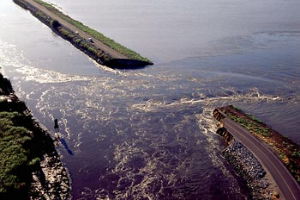 After Hurricane Katrina devastated New Orleans, our nation’s crumbling infrastructure was finally placed in the spotlight, with much of the attention focused on our levees. However, one particular region stood out among the rest. Of all the thousands of dams and embankments in our country, by far the most fragile levees, exist in California’s San Joaquin Valley Delta.
After Hurricane Katrina devastated New Orleans, our nation’s crumbling infrastructure was finally placed in the spotlight, with much of the attention focused on our levees. However, one particular region stood out among the rest. Of all the thousands of dams and embankments in our country, by far the most fragile levees, exist in California’s San Joaquin Valley Delta.
Over the past 150 years, farmers in the delta have built hundreds of levees out of pretty much anything they could find. They’re basically just dirt walls without any kind of foundation. And as time went on, the land that was protected by these structures began to sink, and farmers had to pile on more dirt to build the walls higher and wider. Despite these efforts, they still fail from time to time, and they have to be patched up on a case by case basis. By far, these are the most vulnerable water retaining structures in the entire nation.
And if they did fail, it would likely devastate California’s economy for decades. The delta is home to two major pumping stations, which deliver water everywhere from San Francisco to San Diego. If the levees fail, salt water from the San Francisco Bay will rush into the delta, and the pumps will have to be shut down. 25 million people and 3 million acres of farmland will be without water for weeks, or even months.
So this won’t just be a problem for California. It could easily send millions of refugees across the United States, and devastate a region that grows nearly half of America’s produce. And the overnight destruction of one of the largest economies in the world would have lasting effects, across our nation and even the world.
So what could cause such a massive disaster? Being California, earthquakes are the most obvious culprit. They could easily liquefy the shoddy dams at a moments notice, and the region is overdue for a major earthquake. However, a big storm is much more likely to bring these structures down. Altogether, there’s a 64% chance that the levees will fail over the next 50 years. All it would take is a particularly nasty storm to level to levies.
And the drought would actually make things worse. During dry weather, the freshwater levels of the delta are much lower. If multiple levees fail, even more seawater will rush into the delta. Granted, the freshwater from the storm would help push back the saltwater, but only temporarily. If the dams break then there is nothing holding that storm water in. It would be a race against time to repair the levees before the flood fully subsides, and the seawater comes rushing back.
California now finds itself in a rather scary situation. The state has been devastated by drought for several years, but now the rain may be coming back in a very big way. Researchers with the National Weather Service and NASA have concluded, based on climate data in the Pacific Ocean, that a record-breaking El Niño may be on its way this year.
If California receives the brunt of this weather pattern, it might dump enough rain to topple these fragile levees. The last time a really strong El Niño hit California was in 1997, which managed to cause 29 levee breaches, and destroyed 585 homes in the San Joaquin Delta. This El Niño is expected to be even more fearsome than any of its known predecessors, and it may very well change life as we know it in America.
References
http://www.wired.com/2015/08/californias-katrina-coming/
This article was originally published at Ready Nutrition™ on September 4th, 2015






